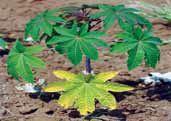Nutritional Deficiencies/Disorders of Castor
Nutritional Deficiencies/Disorders of Castor
Nitrogen
 The deficiency of nitrogen leads to formation of yellowish or light green coloured leaves and plant becomes stunted. The leaves and young fruits tend to drop prematurely. The kernels of cereals and the seed of other crops do not attain their normal size, and become shriveled and light in weight.
The deficiency of nitrogen leads to formation of yellowish or light green coloured leaves and plant becomes stunted. The leaves and young fruits tend to drop prematurely. The kernels of cereals and the seed of other crops do not attain their normal size, and become shriveled and light in weight.
Correction measure: Apply 8-10 Kg N/acre as top dressing or foliar spray of urea @ 2-3 percent.
Phosphorous
Deficiency of phosphorus leads to restricted root and shoot growth, leaves may shed prematurely, flowering and fruiting may be delayed considerably. In case of potato tubers phosphorus deficiency leads to formation of rusty brown lesions.
Potassium
Potassium deficiency causes stunting in growth with shortening of internodes and bushy in appearance, brings about chlorosis, i.e., yellowing of leaves and leaf scorch in case of fruit trees. It is also responsible for the ‘dying back tips’ of shoots. Its deficiency leads to reduction in photosynthesis, blackening of tubers in case of potato, tips or margin of lower leaves of legumes, maize, cotton, tobacco and small grains are either scorched or burnt.
Calcium
Deficiency of calcium leads to ‘Die back’ at the tips and margins of young leaves. Normal growth of plants is arrested i.e., roots may become short, stubby and bushy, leaves become wrinkled and the young leaves of cereal crops remain folded. The acidity of cell sap increases abnormally and it hampers the physiological function of plant. As a result of which plant suffers and causes the death of plant at last.
Magnesium
Deficiency of magnesium leads to yellowing of the older leaves known as chlorosis. Acute deficiency of magnesium also causes premature defoliation. In case of maize the leaves develop interveinal white strips, in cotton they change to purplish red, veins remain dark green, in soybean they turn yellowish and in apple trees, brown patches (blotches) appear on the leaves.
Sulphur
The deficiency of sulphur leads to slow growth with slender stalks, nodulation in legumes may be poor and nitrogen fixation is reduced. The young leaves turn yellow and the root and stems become abnormally long and develop woodiness. In case of fruit trees, the fruits become light green, thick skinned and less juicy. Sulphur deficient plant produces less protein and oil.
IPM for Castor
To know the IPM practices for Castor, click here.
Source: NIPHM and Directorate of Plant Protection, Quarantine & Storage
Last Modified : 2/13/2020
This topic provides information about Nutrient Def...
This topic covers information about Cucurbitaceous...
This topic covers the information related to Nutri...
This topic covers the information related to Nutri...
